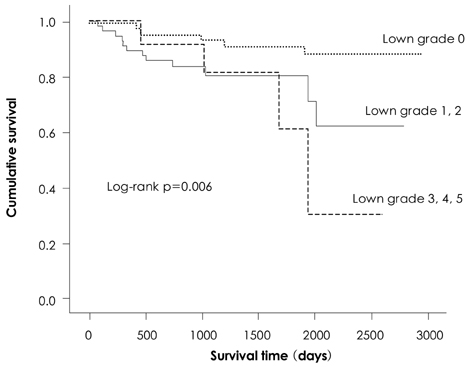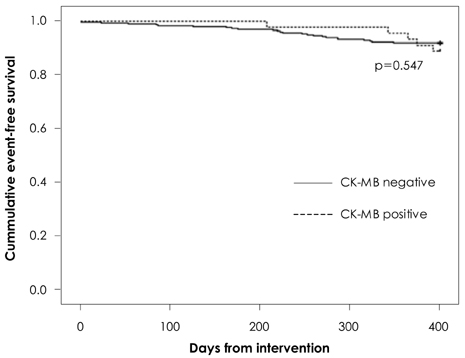Korean Circ J.
2008 Jan;38(1):17-22. 10.4070/kcj.2008.38.1.17.
Prognostic Significance of the Lown Grades and Late Potentials in Patients after Myocardial Infarction
- Affiliations
-
- 1Cardiology Division, Department of Internal Medicine, Daegu Catholic University Medical Center, Daegu, Korea. mdleeys@cu.ac.kr
- KMID: 2225869
- DOI: http://doi.org/10.4070/kcj.2008.38.1.17
Abstract
- BACKGROUND AND OBJECTIVES
The aims of this study were to assess the long term overall survival of patients after an acute myocardial infarction (AMI), and to determine the association of survival with the occurrence of ventricular arrhythmia, as recorded by Holter electrocardiography (ECG) and signal-averaged electrocardiography (SAECG).
SUBJECTS AND METHODS
One hundred fifty two patients with an AMI were enrolled between January 2000 and August 2006. SAECG and Holter ECG were performed before hospital discharge (at range of 2-10 day). The grading system of Lown was used to evaluate the ventricular premature beats on Holter ECG. Three groups of patients were identified based on the seriousness of the ventricular arrhythmia, as identified by the Holter ECG: Lown grade 0, Lown grades 1, 2 and Lown grades 3, 4, 5. SAECG was performed with a high pass frequency of 25 Hz and 40 Hz. The presence of late potentials (LPs) recorded on SAECG was evaluated. The predictors for survival were assessed using Cox's proportional hazard model and Kaplan-Meier analysis.
RESULTS
The mean duration of follow-up was 45.8+/-25.5 months. Twenty four patients (15.8%) died during follow-up. The multivariate predictors of all cause death included age [hazard ratio (HR)=1.25, 95% confidence interval (CI)=1.08-1.47, p=0.003] and Lown grades 3, 4 and 5 (HR=19.17, 95% CI=1.25-290.80, p=0.034). Survival analysis did not show a significant relationship between LPs and overall patient survival. The only predictors for overall mortality were age and the Lown grade.
CONCLUSION
SAECG did not predict mortality for the patient with AMI. The ventricular arrhythmias recorded by conventional Holter before hospital discharge may be a useful noninvasive prognostic test after an AMI.
MeSH Terms
Figure
Reference
-
1. Shin DG. Current perspectives on methods for predicting risk of sudden cardiac death. Korean Circ J. 2002. 32:637–645.2. Dennis AR, Richards DA, Cody DV, et al. Prognostic significance of ventricular tachycardia and fibrillation induced at programmed stimulation and delayed potentials detected on the signal-averaged electrocardiograms of survivors of acute myocardial infarction. Circulation. 1986. 74:731–745.3. Gomes JA, Mehra R, Barreca P, el-Sherif N, Hariman R, Holtzman R. Quantitative analysis of the high-frequency components of the signal-averaged QRS complex in patients with acute myocardial infarction: a prospective study. Circulation. 1985. 72:105–111.4. Breithardt G, Boggrefe M. Recent advances in the identification of patients at risk of ventricular tachyarrhythmias: a role of ventricular late potentials. Circulation. 1987. 75:1091–1096.5. Kuchar DL, Thorburn CW, Sammel NL. Late potentials detected after myocardial infarction: natural history and prognostic significance. Circulation. 1986. 74:1280–1289.6. Breithardt G, Cain ML, el-Sherif N, et al. Standards for analysis of ventricular late potentials using high-resolution signal-averaged electrocardiography. J Am Coll Cardiol. 1991. 17:999–1006.7. Simson MB. Noninvasive identification of patients at high risk for sudden cardiac death: signal-averaged electrocardiography. Circulation. 1992. 85:Suppl. I145–I151.8. Breithardt G, Wichter T, Fetsch T, et al. The signal-averaged ECG: time-domain analysis. Eur Heart J. 1993. 14:Suppl E. 27–32.9. Simson MB, Euler D, Michelson EL, Falcone RA, Spear JF, Moore EN. Detection of delayed ventricular activation on the body surface in dogs. Am J Physiol. 1981. 241:H363–H369.10. el-Sherif N, Scherlag BJ, Lazzara R. Electrode catheter recording during malignant ventricular arrhythmia following experimental acute myocardial ischemia: evidence for re-entry due to conduction delay and block in ischemic myocardium. Circulation. 1975. 51:1003–1014.11. Spear JF, Richards DA, Blake GL, Simson MB, Moore EN. The effects of premature stimulation of His bundle on epicardial activation and body surface late potentials in dogs susceptible to sustained ventricular tachyarrhythmias. Circulation. 1985. 72:214–224.12. Garder PI, Ursell PC, Fenoglio JJ Jr, Wit AL. Electrophysiologic and anatomic basis for fractionated electrograms recorded from healed myocardial infarcts. Circulation. 1985. 72:596–611.13. Gang ES, Lew AS, Hong M, Wang FZ, Siebert CA, Peter T. Decreased incidence of ventricular late potentials after successful thrombolytic therapy for acute myocardial infarction. N Engl J Med. 1989. 321:712–716.14. Kontoyannis D, Nanas J, Moulopoulos S. Late potential and late potentialindex during thrombolysis as markers of successful thrombolysis. Hellenic J Cardiol. 1992. 33:201–209.15. Kozer LM, Cheriparambil KM, Schifter DR, Saul BI, Reddy CV. Clinical significance of variability of ventricular late potentials detected before discharge in patients after myocardial infarction. Am Heart J. 2000. 139:134–141.16. Huikuri HV, Mäkikallio TH, Raatikainen MJ, Perkiomaki J, Castellanos A, Myerburg RJ. Prediction of sudden cardiac death: appraisal of the studies and methods assessing the risk of sudden arrhythmic death. Circulation. 2003. 108:110–115.17. Bigger JT Jr, Fleiss JL, Kleiger R, Miller JP, Rolnitzky LM. The relationships among ventricular arrhythmias, left ventricular dysfunction, and mortality in the 2 years after myocardial infarction. Circulation. 1984. 69:250–258.18. Maggioni AP, Zuanetti G, Franzosi MG, et al. Prevalence and prognostic significance of ventricular arrhythmias after acute myocardial infarction in the fibrinolytic era. Circulation. 1993. 87:312–322.19. Hohnloser SH, Klingenheben T, Zabel M, Schopperl M, Mauss O. Prevalence, characteristics and prognostic value during longterm follow-up of nonsustained ventricular tachycardia after myocardial infarction in the thrombolytic era. J Am Coll Cardiol. 1999. 33:1895–1902.20. Makikallio TH, Bathel P, Schneider R, et al. Prediction of sudden cardiac death after acute myocardial infarction: role of Holter monitoring in the modern treatment era. Eur Heart J. 2005. 26:762–769.21. el-Sherif N, Turitto G. Risk stratification and management of sudden cardiac death: a new paradigm. J Cardiovasc Electrophysiol. 2003. 14:1113–1119.22. Lown B, Wolf M. Approaches to sudden death from coronary heart disease. Circulation. 1971. 44:130–142.23. Huikuri HV, Castellanos A, Myerburg RJ. Sudden death due to cardiac arrhythmias. N Engl J Med. 2001. 345:1473–1482.24. Boehrer JD, Glamann DB, Lange RA, et al. Effect of coronary angioplasty on late potentials one to two weeks after acute myocardial infarction. Am J Cardiol. 1992. 70:1515–1519.25. Sohn JW, Shin DG, Kim DH, et al. Non-invasive parameters, including a low left ventricular ejection fraction, for predicting sudden cardiac death in Korean post myocardial infarction patients. Korean Circ J. 2006. 36:431–436.26. Abildstrom SZ, Ottesen MM, Rask-Madsen C, et al. Sudden cardiovascular death following myocardial infarction: the importance of left ventricular systolic dysfunction and congestive heart failure. Int J Cardiol. 2005. 104:184–189.27. Moon SJ, Kwon JG, Jang DW, et al. Signal averaged electrocardiography using holter tape in patients without heart disease. Korean Circ J. 1997. 27:42–48.28. Cardner PI, Ursell PC, Fenoglio JJ Jr, Wit AL. Electrophysiologic and anatomic basis for fractionated electrograms recorded from healed myocardial infarcts. Circulation. 1985. 72:596–611.29. Breithardt G, Schwarzmaier J, Borggrefe M, Haerten K, Seipel L. Prognostic significance of late ventricular potentials after acute myocardial infarction. Eur Heart J. 1983. 4:487–495.
- Full Text Links
- Actions
-
Cited
- CITED
-
- Close
- Share
- Similar articles
-
- Effects of Patency of the Infarct-Related Artery on the Signal-Averaged ECG in Acute Myocardial Infarction
- The Change of Late Potential in Acute Myocardial Infarction and the Influence of Patency of Infarct-Related Artery on Its Development
- Early and Late Prognostic Factors of Acute Myocardial Infarction
- A Case of Acute Myocardial Infarction Associated with Myocardial Bridge Treated by Primary Coronary Stenting
- Late Stent Thrombosis Associated with Late Stent Malapposition after Drug-Eluting Stenting: A Case Report




